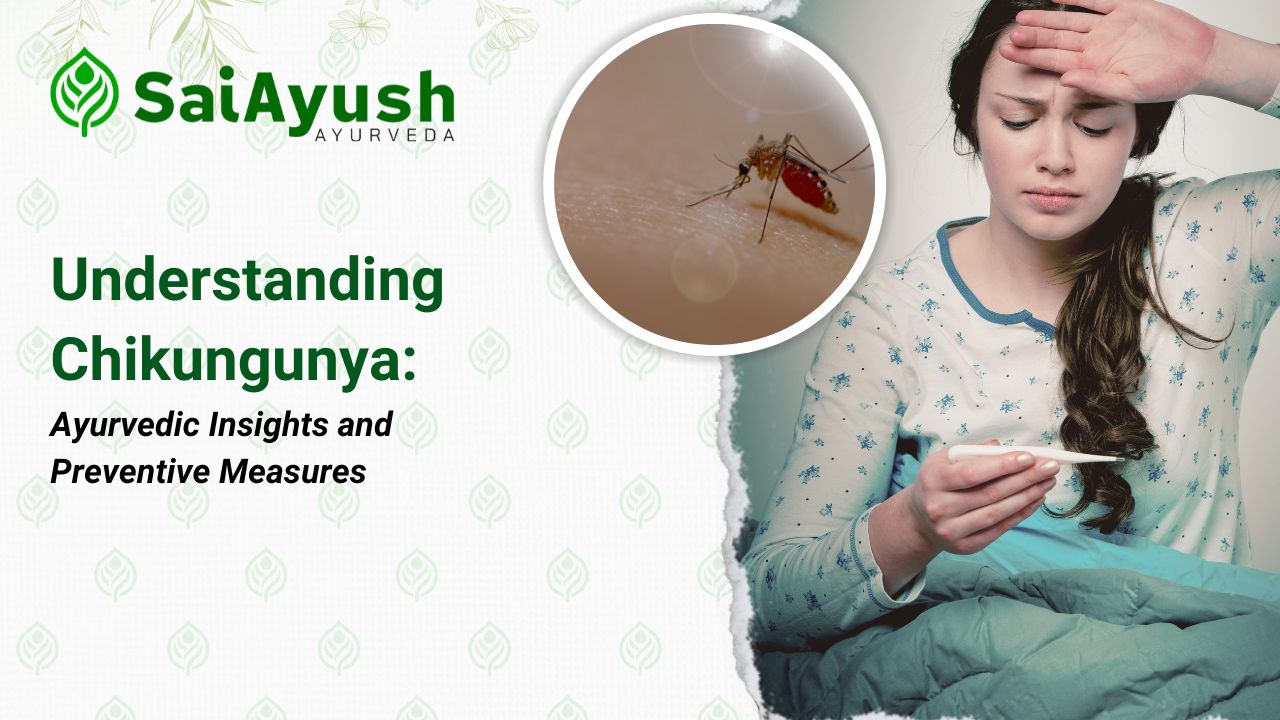Introduction
Chikungunya is a mosquito-borne viral disease that has become a significant health concern in many tropical and subtropical regions. In this blog post, I will delve into what Chikungunya is, its signs and symptoms, Ayurvedic perspectives, treatments, and preventive measures. Additionally, I’ll discuss the role of Ayurvedic body massage according to seasons and body Prakriti (constitution), highlighting its benefits and steps for effective practice.
What is Chikungunya?
Chikungunya is a viral infection transmitted to humans by infected mosquitoes, primarily Aedes aegypti and Aedes albopictus. The word “Chikungunya” originates from the Kimakonde language, meaning “to become contorted,” referring to the stooped appearance of sufferers with joint pain.
What are the Signs and Symptoms of Chikungunya?
The symptoms of Chikungunya typically appear 4-8 days after a mosquito bite. They include:
- Fever: Sudden onset of high fever, which can reach up to 104°F (40°C).
- Joint Pain: Severe joint pain (arthralgia), mainly in the wrists, knees, ankles, and fingers.
- Headache: Intense headache, often accompanied by muscle pain.
- Rash: Skin rash, usually appearing a few days after the fever.
- Fatigue: Extreme tiredness and a general feeling of being unwell.
- Nausea: Nausea and vomiting in some cases.
Perspective in Ayurveda
Ayurveda, the ancient Indian system of medicine, offers a holistic approach to understanding and managing Chikungunya. It views diseases as an imbalance of the body’s three doshas: Vata, Pitta, and Kapha. In Ayurveda, Chikungunya is considered a type of Jwara (fever) and Vata-Rakta (a condition involving blood and Vata dosha). The primary focus is on balancing the aggravated doshas and detoxifying the body.
Treatments in Ayurveda
Ayurvedic treatments for Chikungunya focus on alleviating symptoms, strengthening the immune system, and restoring balance to the doshas. Key treatments include:
Herbal Remedies
- Guduchi (Tinospora cordifolia): Known for its immune-boosting properties, Giloy helps in reducing fever and joint pain.
- Ashwagandha (Withania somnifera): Helps in reducing inflammation and joint pain.
- Tulsi (Ocimum sanctum): Known for its antiviral and anti-inflammatory properties.
Panchakarma Therapy
Panchakarma is a detoxification therapy that helps in eliminating toxins from the body. It includes procedures like:
- Abhyanga (Oil Massage): A daily oil massage with medicated oils to reduce Vata dosha and alleviate joint pain.
- Swedana (Herbal Steam Therapy): Helps in reducing stiffness and pain in the joints.
- Basti (Medicated Enema): To balance the Vata dosha and detoxify the body.
Preventive Measures in Ayurveda
Preventing Chikungunya involves both general and Ayurvedic-specific measures:
General Preventive Measures
- Avoid Mosquito Bites: Use mosquito repellents, wear long-sleeved clothing, and sleep under mosquito nets.
- Eliminate Mosquito Breeding Sites: Ensure there is no stagnant water around your living area.
Ayurvedic Preventive Measures
- Herbal Teas: Consuming herbal teas made from Tulsi, Ginger, and Turmeric to boost immunity.
- Dietary Adjustments: Incorporate anti-inflammatory foods like turmeric, ginger, and garlic in your diet.
- Daily Regimen (Dinacharya): Following a daily routine that includes oil pulling, nasal drops (Nasya), and regular exercise to maintain dosha balance.
Ayurvedic Body Massage According to Seasons and Body Prakriti
Body massage, or Abhyanga, is an integral part of Ayurvedic therapy. It offers numerous benefits, including improved circulation, detoxification, and relaxation. The type of oil and massage technique can vary according to the season and body Prakriti.
Massage Benefits
- Improves Blood Circulation: Enhances the flow of blood and nutrients to various parts of the body.
- Detoxifies the Body: Helps in the removal of toxins through increased lymphatic drainage.
- Relieves Stress and Fatigue: Promotes relaxation and reduces stress.
- Alleviates Pain and Stiffness: Particularly beneficial for joint and muscle pain.
Massage Steps According to Ayurveda
- Choosing the Right Oil: Select an oil based on your body Prakriti and the season. For instance, sesame oil is warming and good for Vata, while coconut oil is cooling and suitable for Pitta.
- Warm the Oil: Gently heat the oil before application to enhance its absorption.
- Application: Apply the oil generously over the entire body.
- Massage Technique: Use long strokes on the limbs and circular motions on the joints.
- Focus Areas: Pay extra attention to the soles of the feet, scalp, and joints.
- Duration: Massage for at least 15-30 minutes.
- Rest and Cleanse: Allow the oil to sit for 15-20 minutes before taking a warm bath.
Conclusion
Chikungunya is a debilitating disease that requires comprehensive management to alleviate its symptoms and prevent recurrence. Ayurveda offers a holistic approach through herbal remedies, Panchakarma therapy, and lifestyle modifications. Incorporating Ayurvedic practices like body massage can significantly improve overall health and well-being. Remember, prevention is always better than cure, so take proactive steps to protect yourself from mosquito bites and maintain a balanced lifestyle.
FAQs
Q: What is Chikungunya?
A: Chikungunya is a viral disease transmitted by mosquitoes, characterized by sudden fever, severe joint pain, and other symptoms like rash and headache.
Q: What are the signs and symptoms of Chikungunya?
A: The main symptoms include high fever, severe joint pain, headache, muscle pain, rash, fatigue, and sometimes nausea.
Q: How does Ayurveda view Chikungunya?
A: Ayurveda sees Chikungunya as an imbalance of the Vata and Rakta (blood) doshas, focusing on detoxification and dosha balance for treatment.
Q: What are the Ayurvedic treatments for Chikungunya?
A: Treatments include herbal remedies like Giloy and Ashwagandha, Panchakarma therapy, and dietary adjustments to balance the doshas and boost immunity.
Q: How can I prevent Chikungunya?
A: Preventive measures include avoiding mosquito bites, eliminating breeding sites, consuming immunity-boosting herbs, and following a balanced daily regimen (Dinacharya).
Q: What are the benefits of Ayurvedic body massage?
A: Ayurvedic body massage improves blood circulation, detoxifies the body, relieves stress, and alleviates pain and stiffness, tailored to individual body Prakriti and seasons.
Discover the healing power of Ayurveda with our latest article at Sai Ayush Ayurveda Hospitals! Dive into the age-old wisdom that can rejuvenate your body and mind. Click here to read more:



0 Comments